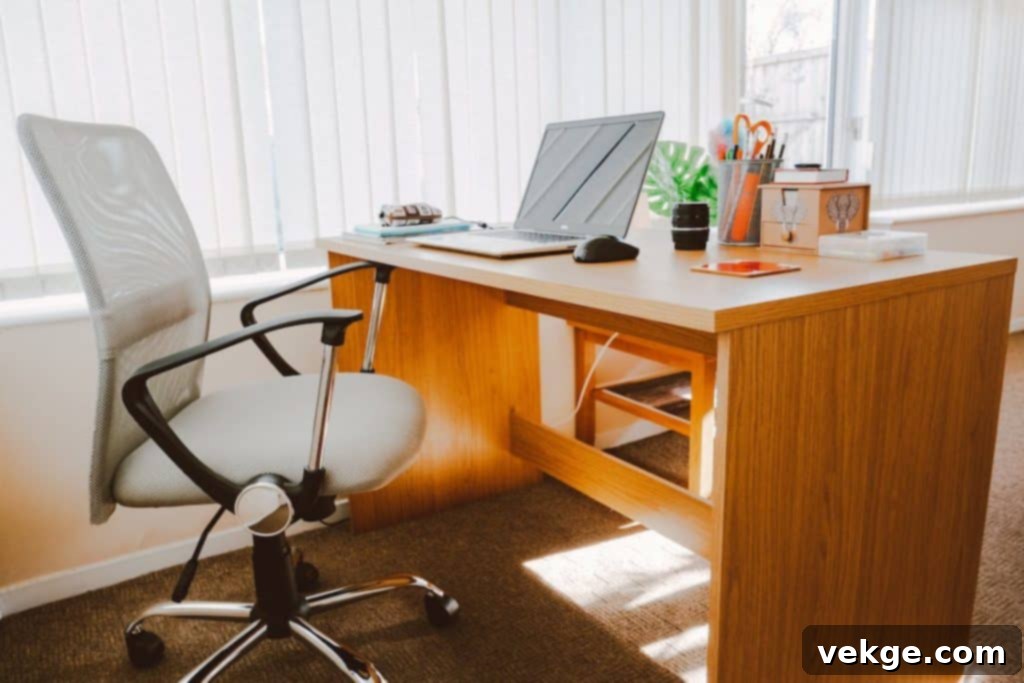The Ultimate Guide to Setting Up Your Productive Home Office: Essential Gear for Remote Work Success
The landscape of work has profoundly shifted, with a growing number of individuals embracing the flexibility and convenience of remote work. Many professionals are now choosing to set up a dedicated home office, moving away from the daily commute and rigid traditional office environments. Employers, too, have increasingly recognized the significant benefits of allowing their teams to work efficiently from virtually anywhere.
Establishing a well-equipped home office has become a cornerstone of modern professional life. It not only helps employees save on transportation costs and commuting time but also empowers them to meet and exceed employer or client expectations with greater autonomy. However, knowing exactly what to include in your home workspace can be a challenge. Some tend to over-invest in unnecessary gadgets, while others underestimate their needs, leading to repeated purchases and wasted money. To avoid these pitfalls, this comprehensive guide outlines the absolute essentials for creating a functional, comfortable, and highly productive home office environment, regardless of your specific job role or industry.
1. A Stable, High-Speed Internet Connection

In today’s interconnected world, a fast and reliable internet connection isn’t just a convenience; it’s the absolute foundation of any effective home office. Without it, you might struggle to keep pace with colleagues, participate in video conferences, access cloud-based tools, or transfer large files. Many companies rely on seamless collaboration, demanding that employees connect and cooperate effortlessly, irrespective of their physical location.
When selecting an internet service provider (ISP), it’s crucial to consider both speed and stability. While high download and upload speeds are vital for quick data transfer and smooth video calls, stability ensures your connection remains consistent, preventing frustrating drops during important meetings or while working on critical tasks. Look for providers offering fiber optic or high-speed cable options, and review their service reliability records.
Beyond the ISP, your hardware plays a significant role. A high-quality router is essential for distributing your internet connection efficiently throughout your home. Consider modern routers with Wi-Fi 6 technology for better performance and capacity. If you encounter dead zones or weak signals in your home office area, a Home Signal Booster or a mesh Wi-Fi system from a reputable manufacturer can significantly enhance coverage and signal strength, ensuring you stay connected and productive without interruption.
2. An Ergonomic Desk
Your desk is more than just a surface; it’s a central component that significantly influences your comfort, posture, and overall work experience in a home office. Investing in an ergonomic desk is paramount for maintaining good health and maximizing productivity during long working hours. Unlike fixed-height desks that can lead to discomfort, an ergonomic desk typically allows users to easily adjust its height to suit their body proportions and the specific task at hand.
Many remote workers prefer a standing desk, which offers the flexibility to alternate between sitting and standing throughout the day. This simple change can improve circulation, reduce back pain, and boost energy levels. Some advanced desks even integrate features like treadmills or spin bikes, enabling gentle exercise while you work. When choosing a desk, ensure it provides ample surface area to comfortably accommodate your laptop or desktop setup, external monitors, and other essential office supplies, helping you maintain an organized and clutter-free workspace. Consider options with built-in cable management to keep wires tidy and out of sight.
3. An Adjustable Office Chair

Even the most perfect ergonomic desk won’t provide optimal comfort and support if paired with an inadequate chair. An adjustable, high-quality ergonomic office chair is arguably the most crucial investment for anyone setting up a home office, especially for those who spend many hours seated. Such a chair should allow for multiple adjustments, including seat height, depth, armrest height, and lumbar support, enabling you to customize it perfectly to your body and preferred posture.
Modern ergonomic chairs are designed with features like soft, yet firm, padding, breathable materials, and generous depth to support your hips and reduce pressure points. Proper lumbar support is vital for maintaining the natural curve of your spine, significantly minimizing the risk of back and neck injuries, tension headaches, and long-term musculoskeletal issues. While it might seem like a considerable expense, a quality ergonomic chair is an investment in your health, comfort, and sustained productivity, paying dividends in well-being over time.
4. Adequate Lighting
Effective lighting is often underestimated but plays a critical role in your home office’s ambiance, your mood, and most importantly, your eye health. While natural light is ideal, maximizing its benefits by positioning your desk near a window (avoiding direct glare) should be a priority. However, natural light alone is rarely sufficient, especially during evenings, overcast days, or for specific tasks.
For your home office, a layered lighting approach is recommended, combining ambient, task, and accent lighting. Task lighting, such as a good desk lamp, is crucial for illuminating your workspace without causing eye strain. Experts often recommend using LED bulbs or lamps that produce bright, natural-looking light with an appropriate color temperature (around 4000K-5000K, often labeled as “daylight” or “cool white”) to mimic natural light and reduce fatigue. Avoid harsh overhead lighting that creates shadows or screen glare. Experiment with different lamp types and positions to find the setup that best suits your needs, minimizes shadows, and creates a well-lit, inviting workspace.
5. A Computer or Tablet

At the heart of almost every home office is a reliable computer or tablet, serving as your primary tool for productivity. The choice between a desktop and a laptop depends on your specific tasks and preferences. If you opt for a desktop, consider a large, high-resolution monitor (or even dual monitors) to minimize eye strain and enhance multitasking capabilities. For laptop users, an external monitor, a separate keyboard, and a mouse can significantly improve ergonomics and comfort. A laptop stand can also help elevate your screen to eye level, preventing neck and shoulder discomfort.
To maintain a clean and uncluttered workspace, consider investing in wireless keyboards, mice, and other peripherals. These not only reduce cable clutter but also offer greater flexibility. If your work style involves frequently moving your home office setup around, a lightweight laptop, a portable stand, and a movable table can provide the necessary flexibility to work comfortably from various locations within your home, ensuring your productivity isn’t tied to a single spot.
6. A Durable Chair Mat
While seemingly a minor detail, a tough chair mat is a smart and budget-friendly addition to any home office, significantly enhancing both comfort and the longevity of your flooring. Many office chairs, especially those with rolling casters, can scratch or damage hard floors and wear down carpets over time. This damage can accumulate quickly, potentially leading to costly repairs or replacements in just a few months.
A good chair mat creates a smooth, resistant surface that protects your flooring from indentations, scuffs, and general wear and tear caused by chair movement. Furthermore, it allows your chair to glide effortlessly, reducing the effort required to move around your workspace. This seemingly small detail can prevent frustration and improve your comfort throughout the day. Choose a mat specifically designed for your floor type – whether it’s carpet, hardwood, laminate, or tile – and ensure it’s large enough to accommodate your chair’s full range of movement beneath your desk.
7. Inspiring Home Office Decorations
Working from home often requires a strong sense of self-motivation, as the natural camaraderie and oversight of a traditional office environment are absent. Therefore, designing an attractive and inspiring home office is not merely about aesthetics; it’s about creating a space that fuels your focus, creativity, and drive. Personalizing your workspace can have a profound psychological impact, making work feel less like a chore and more like an engaging pursuit.
Consider incorporating elements that genuinely motivate you. This could include artwork, photographs of loved ones, inspiring quotes, or even vision boards reflecting your goals and aspirations. Plants are an excellent addition, known to improve air quality, reduce stress, and add a touch of natural beauty to your surroundings. Thoughtful decoration helps to differentiate your work zone from other living spaces, signaling to your brain that it’s time to be productive. Choose colors and textures that evoke a sense of calm or energy, depending on your preferences, to craft an environment where you genuinely enjoy spending time and feel inspired to achieve your best.
8. Robust Cloud-Based Data Backup
Imagine dedicating weeks to a complex project only to lose the final document due to a hardware malfunction, accidental deletion, or even a cyberattack. The consequences could be devastating, potentially jeopardizing your job or critical client relationships. For home office users, a robust data backup solution is not just recommended; it’s absolutely essential to safeguard your invaluable work and ensure business continuity.
While some companies provide automatic backup systems for office computers, remote workers are typically responsible for their own data security. Cloud-based backup services offer an excellent solution, automatically syncing and storing your files on remote servers. This protects your data from local hardware failures and allows you to access your files from any device, anywhere. Look for services that offer version control, strong encryption, and easy file recovery. Complementing cloud storage with a local external hard drive for an additional layer of security can provide ultimate peace of mind. Prioritizing data backup is a crucial step in maintaining professionalism and avoiding potential work disruptions.
9. Relevant Computer Programs and Software
In the digital age, virtually every company relies on an array of computer programs to manage operations, facilitate communication, and complete tasks. For the home office professional, having the right software is just as critical as having the right hardware. Essential software typically includes a comprehensive productivity suite (such as Microsoft 365 or Google Workspace) for word processing, spreadsheets, and presentations. Communication tools like Slack, Zoom, or Microsoft Teams are indispensable for virtual meetings and team collaboration.
Depending on your role, you might also require specialized software for project management (e.g., Asana, Trello), graphic design, video editing, or accounting. While some employers provide free licenses for necessary programs, others may require employees to subscribe or purchase their own. Additionally, cybersecurity software, including robust antivirus and a Virtual Private Network (VPN), is paramount to protect your data and privacy when working from home. These digital tools form the backbone of your remote workflow, enabling efficient task completion and seamless interaction with your team and clients.
10. Smart Storage Solutions
The notion that remote work makes everything entirely digital is a common misconception. Even in a paperless-leaning world, you’ll inevitably encounter physical documents that need to be printed, signed, or referenced. Therefore, effective physical storage solutions are just as important as digital organization for maintaining an efficient and tidy home office.
Investing in a filing cabinet, sturdy shelves, or functional storage drawers can keep your workspace organized and prevent the loss of crucial files and documents. Clear labeling and categorization of your stored items will allow for quick retrieval, reducing stress and saving valuable time. Smart storage extends beyond paper; it includes organizing office supplies, cables, and other peripherals. A well-organized home office minimizes clutter, which in turn helps to reduce distractions and foster a clearer, more focused mind. By having a designated place for everything, you create an environment that supports efficient workflow and a professional appearance, even if it’s just for yourself.
Creating a functional and comfortable home office might seem daunting at first, but this comprehensive checklist breaks down the essentials into manageable steps. By prioritizing these key items – from a robust internet connection and ergonomic furniture to crucial software and smart organizational tools – you can lay the foundation for a truly productive and enjoyable remote work experience. Remember to invest in quality products from reputable manufacturers to ensure durability and long-term satisfaction. With these essentials in place, you’ll be well-equipped to kick-start your remote work journey and thrive in your personalized home workstation.
